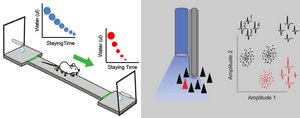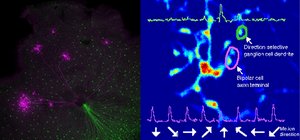
Dr. Duda Kvitsiani did his PhD studies at the Institute of Molecular Pathology (IMP) in Vienna, Austria, and thereafter had a postdoctoral position at the Cold Spring Harbor Laboratory (CSHL), New York, USA. His research focuses on the genetic and neuronal circuit mechanisms that underlie effort based decision-making in flies, rodents and humans. The aim of his research is to build predictive and quantitative models of foraging behavior to uncover the neural and genetic mechanisms that underlie animal decisions. The methods used include molecular genetics, psychophysics, behavioral electrophysiology and optogenetics.

Dr. Keisuke Yonehara did his PhD studies at The Graduate University for Advanced Studies, Okazaki, Japan, and thereafter had a postdoctoral position at the Friedrich Miescher Institute for Biomedical Research, Basel, Switzerland. His research focuses on the structure, function and development of neural circuits in the visual system. He aims for an understanding of the function of different cell types in neuronal circuits. Furthermore, the aim is to understand the genetic and molecular mechanisms of how those circuits are assembled during development. The methods used include two-photon imaging, electrophysiology, optogenetics, trans-synaptic virus, genetic labeling, molecular biology, genomics and behavioral analysis.
Dr. Keisuke Yonehara and Dr. Duda Kvitsiani’s research activities complement the expertise and research programmes of the other current research groups at DANDRITE, where the first two Group Leaders recruited at DANDRITE are focusing on embryonic and reprogrammed stem cells in Parkinson disease (Dr. Mark Denham) and the brain circuitries and behavior in Drosophila (Dr. Anne von Philipsborn). The DANDRITE core groups are focusing on structural biology and electrophysiology of membrane transporters and receptors (Prof. Poul Nissen), sorting/trafficking, trans-synaptic communication and signaling in nerve cells as mediated by sortilin receptors and studied in transgenic animal models (Prof. Anders Nykjær) and molecular cell biology of intracellular signaling networks with focus on Parkinson disease and dementia (Prof. Poul Henning Jensen). Furthermore, the newly appointed Group Leaders are of course highly interested in engaging in new collaborations at Aarhus University, the Aarhus University Hospital and the Danish neuroscience community.

Food resources are often distributed in patches in nature. When a foraging animal discovers a new feeding patch and begins depleting the resource, it must determine how long to continue exploiting the resource before leaving to search for a new patch. If an animal leaves too early, it will not exploit the patch fully, and if it stays too long, it will miss the opportunity to discover new patches. Marginal Value Theorem (MVT) provides a theoretical ‘optimal’ solution to this problem.
Using the framework of MVT, Duda Kvitsiani is particularly interested in how animals allocate effort to forage efficiently in unpredictable environments. By employing quantitative foraging models and carefully designed behavioral assays with extracellular electrophysiology and optogenetics he plans to identify circuit level computations in the mouse brain that subserve foraging decisions. For this he will use a newly developed method to record cell-type specific firing of neurons in freely behaving mice (Kvitsiani et al, Nature 2013). The developed models and behavioral paradigms for mice should also pave the way to uncover the molecular basis of foraging behavior in fruit flies, using reverse genetic screens. Finally, Duda Kvitsiani will aim to determine whether foraging humans use the same strategies as flies and rodents, and whether these strategies are adversely affected in mentally disabled patients. His long term goal is to use ecology inspired quantitative behavioral models to guide and sharpen our questions. Duda Kvitsiani also hopes to take advantage of the diverse scientific cultures at Aarhus University to launch fruitful collaborations in pursuit of this goal.

Keisuke Yonehara’s ultimate goal is to understand the function of neuronal circuits in adults, focusing on the role of cell types and to understand the genetic mechanism of how those neuronal circuits are assembled during development. His research is based on the central hypothesis that functionally important neuronal circuit motifs are repeatedly used across various brain regions and species, and therefore identifying and understanding the structure and function of such motifs could give insights into the functional organisation of the brain. The mouse visual motion circuits, particularly the retina and its direct brain target the superior colliculus, provides us with an approachable substrate to work towards this goal, given its functionally and genetically well-defined cell types, multi-layered organization and tractable visually-guided behaviors. Two key organising principles that characterize not only the visual motion circuits of mammals and insects, but also other neuronal systems, are 1) parallel processing and 2) asymmetry of neuronal connectivity. He has focused, and will continue to focus, on questions relevant to these organising principles.
The logic of his research plan is firstly to identify a computation performed by a given neuronal circuit comprising distinct cell types in the adult brain. Secondly, to investigate how the computation is performed by linking the activity and synaptic connectivity of individual cell types in the circuit to the computation that the circuit achieves. Thirdly, to examine the role of individual cell types in transforming the sensory input into output innate behavior or eye movement control. Finally, to study the genetic mechanisms by which the elementary circuit motifs are assembled, and how its dysfunction can result in disease. He will also develop new genetic and viral technologies that facilitate probing circuit function in healthy and diseased systems.
The Danish Research Institute of Translational Neuroscience – DANDRITE is the Danish node of the Nordic EMBL Partnership for Molecular Medicine and therefore adhere to the EMBL model for international recruitment.
DANDRITE is established with support from the Lundbeck Foundation at Aarhus University. The research scope is on molecular mechanisms underlying intra- and intercellular signaling networks that govern neuronal functionality and circuitry, how these mechanisms define behaviour and are altered in neurological and psychiatric disorders.
DANDRITE is embedded in the vibrant NeuroCampus research community at Aarhus University and Aarhus University Hospital and encompasses genetics, molecular and clinical medicine, bioimaging, cell and animal modeling, structural biology and nanoscience, and with long-standing traditions in membrane proteins and neuroscience.
DANDRITE Group Leader Keisuke Yonehara, keisuke.yonehara@gmail.com
DANDRITE Group Leader Duda Kvitsiani, dkvitsiani@gmail.com
DANDRITE Director and Core Group Leader Prof. Poul Nissen, pn@mb.au.dk
DANDRITE Core Group Leader Poul Henning Jensen, phj@biomed.au.dk
DANDRITE Core Group Leader Anders Nykjær, an@biomed.au.dk
DANDRITE Administrative Officer Else Magård, ema@madalgo.au.dk